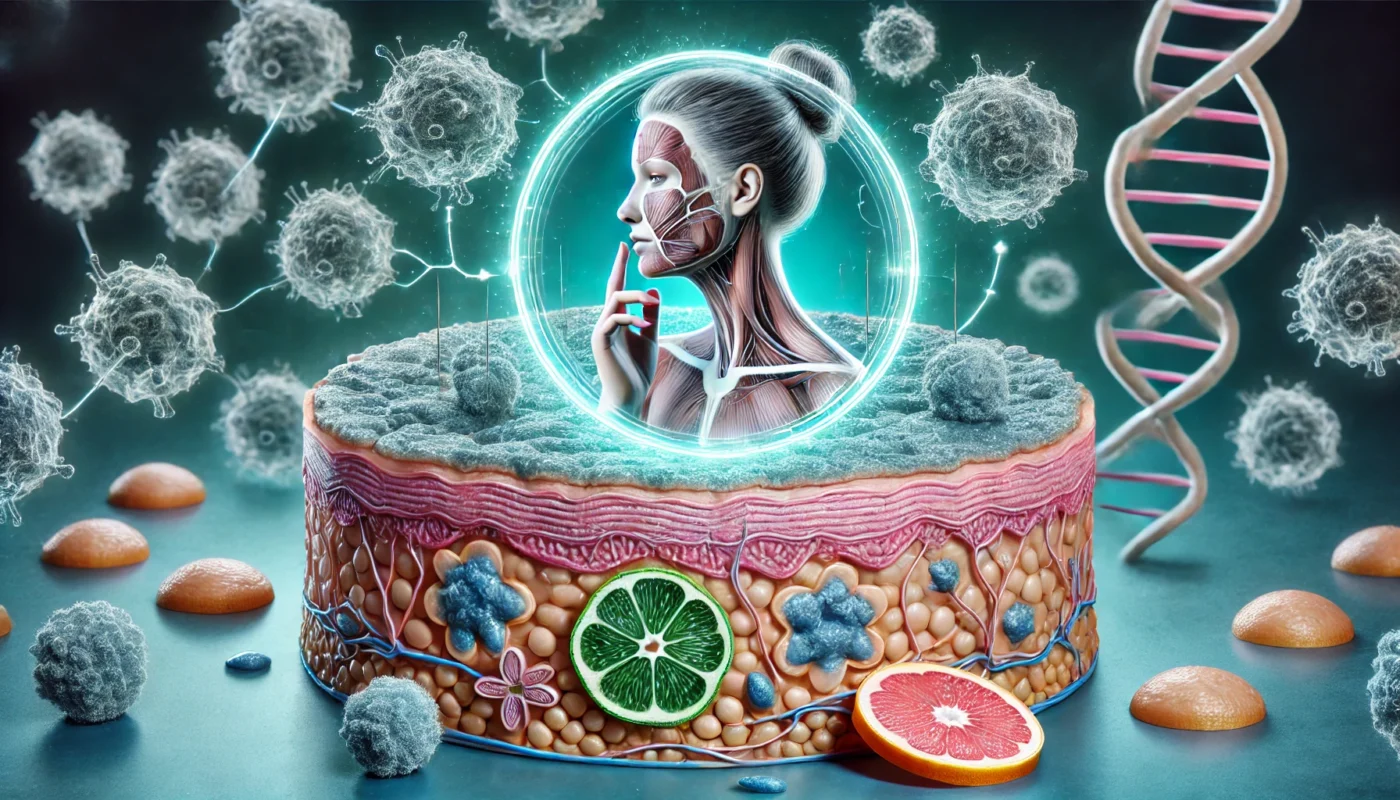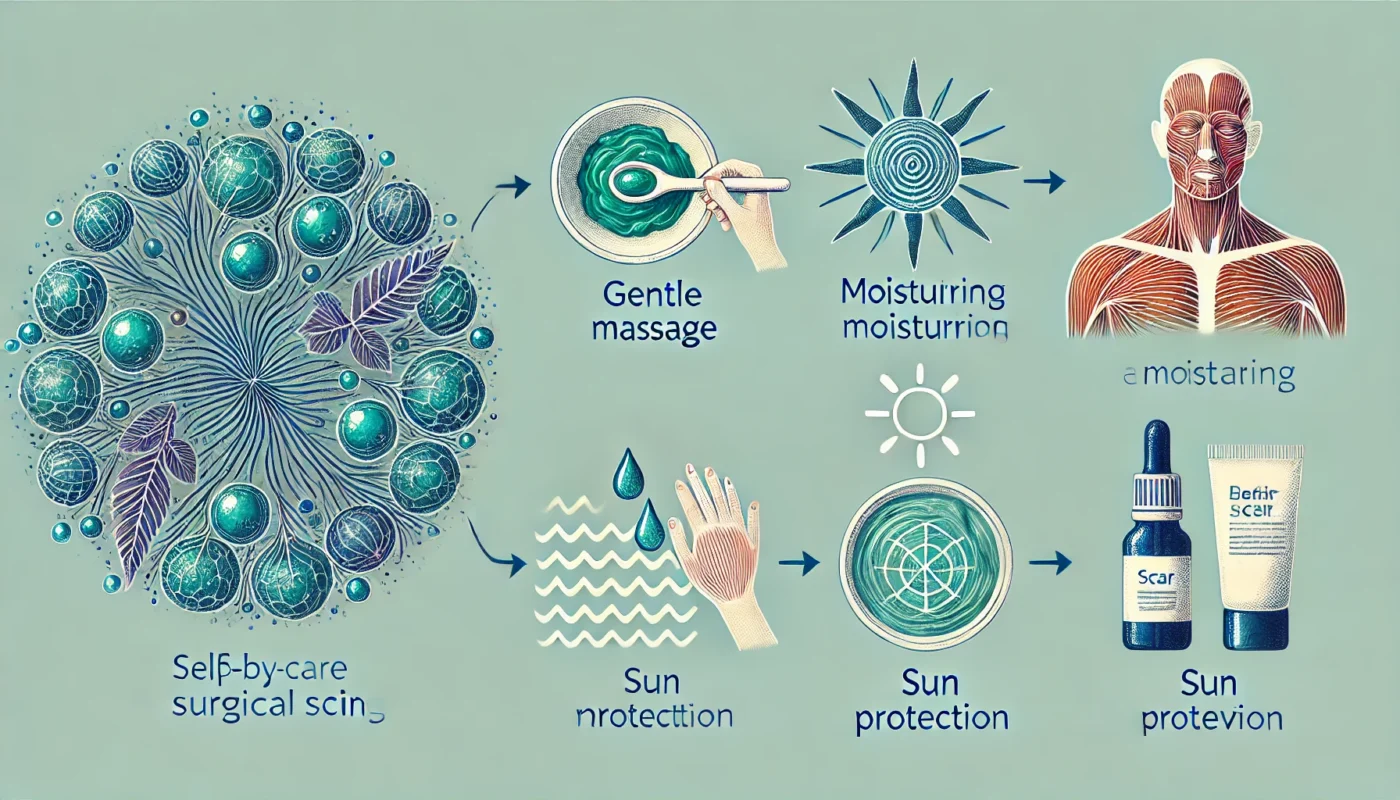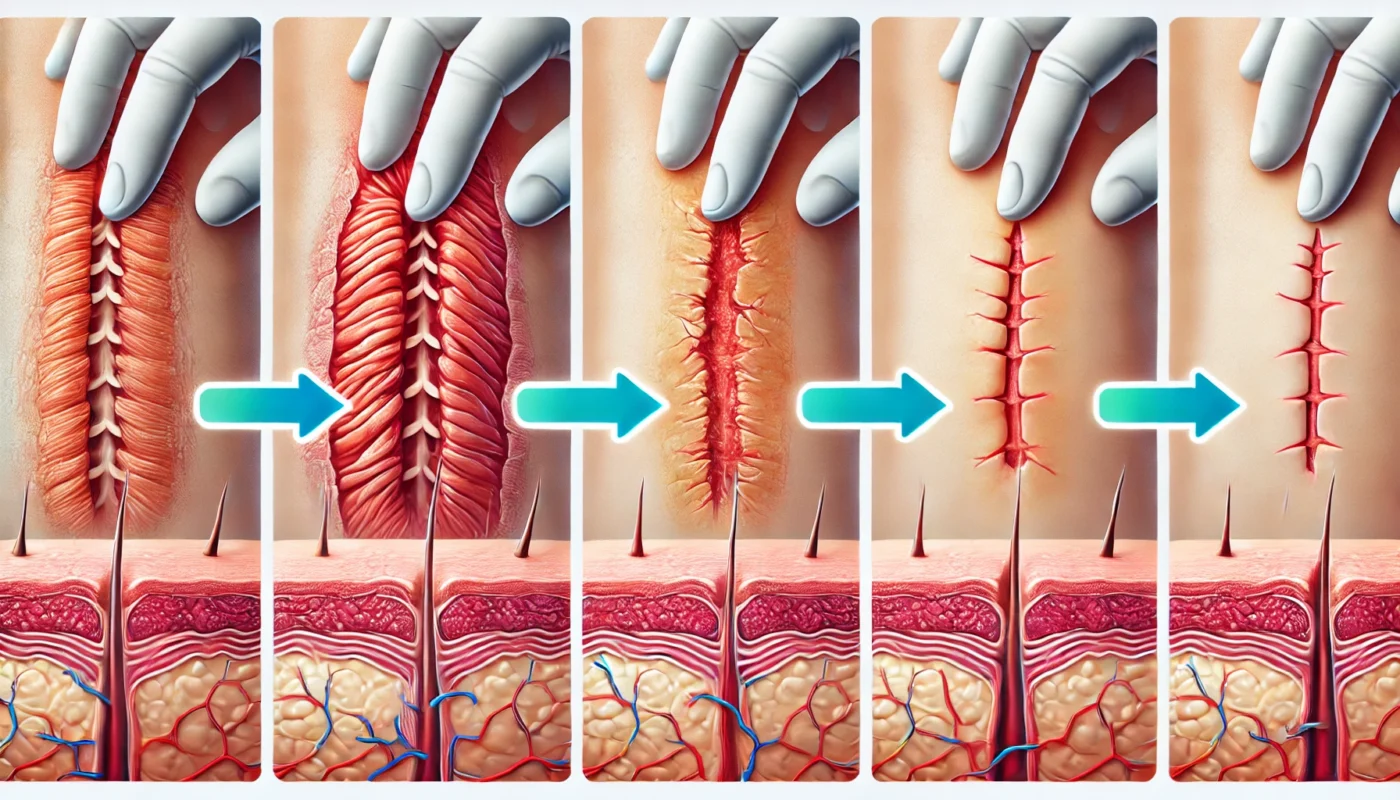Scars are a natural part of the body’s healing process. They form as the body repairs damaged skin and tissues after an injury or surgery. The healing of surgical scars is a complex process that unfolds in several stages, each characterized by distinct biological activities. Let’s explore these stages in greater detail to better understand the journey of scar formation and resolution.
You may also like: Key Factors in Proliferative Wound Healing
Stage 1: Hemostasis
The first stage of scar healing begins immediately after the surgical incision. Known as hemostasis, this phase involves the constriction of blood vessels and the formation of a clot to stop bleeding. Platelets gather at the site, releasing chemicals that attract other cells necessary for healing.
Blood Vessel Constriction
Immediately after a surgical incision, the body acts swiftly to minimize blood loss. Blood vessels constrict almost instantaneously, a reflex action triggered by nerve signals. This constriction is crucial to slow down the blood flow, allowing the clotting process to effectively take place.
Clot Formation
As the blood vessels constrict, platelets, which are small blood cell fragments, rush to the site of injury. These platelets adhere to the exposed collagen fibers in the damaged vessel walls. This aggregation of platelets forms a temporary plug, while clotting factors in the blood initiate a cascade that results in the formation of fibrin strands, solidifying the clot.
Chemical Signaling
During this stage, platelets release various chemicals, including growth factors and cytokines. These substances serve as signals to recruit additional immune cells and fibroblasts to the site. This signaling is essential for transitioning to the subsequent phases of healing, ensuring that the necessary cellular players are in place to promote tissue repair.
Stage 2: Inflammation
The inflammation stage follows shortly after, typically lasting a few days. During this phase, white blood cells, primarily neutrophils and macrophages, infiltrate the wound site to clear debris and prevent infection. This stage is often associated with redness, warmth, swelling, and pain around the incision area.
Immune Response Activation
The arrival of white blood cells marks the onset of the inflammation phase. Neutrophils are the first responders, tasked with engulfing and neutralizing bacteria and debris. They release enzymes that break down damaged tissue, setting the stage for more specialized immune cells.
Role of Macrophages
Following the neutrophils, macrophages take center stage. These versatile cells not only continue the cleanup process but also play a pivotal role in orchestrating the repair process. They release cytokines that promote tissue repair and stimulate the proliferation of fibroblasts, which are essential for the next phase of healing.
Symptoms and Signs
The inflammation phase, while crucial, can be uncomfortable. The increased blood flow to the area causes redness and warmth, while the accumulation of fluid leads to swelling. Pain is a result of pressure on nerve endings and the release of certain chemicals by immune cells. Though these symptoms can be alarming, they are indicative of the body’s active healing efforts.
Stage 3: Proliferation
The proliferation phase can last several weeks. In this stage, fibroblasts, the cells responsible for producing collagen, play a significant role. Collagen is a protein that provides structural support to the skin and tissues. As fibroblasts synthesize collagen, new blood vessels form, and the wound begins to contract and close.
Fibroblast Activity
Fibroblasts are the workhorses of the proliferation phase. They migrate to the wound site, where they begin synthesizing collagen and extracellular matrix components. This newly formed tissue, known as granulation tissue, provides the necessary scaffolding for further tissue repair.
Angiogenesis: Formation of New Blood Vessels
The formation of new blood vessels, or angiogenesis, is another critical aspect of the proliferation phase. These new vessels supply essential nutrients and oxygen to the healing tissue. The process is driven by growth factors released by fibroblasts and macrophages, ensuring that the healing tissue is well-nourished.
Wound Contraction and Closure
As collagen accumulates, the wound edges begin to contract. Myofibroblasts, specialized fibroblasts with contractile properties, play a key role in pulling the wound edges together. This contraction reduces the wound size, facilitating closure and minimizing the potential for scarring.
Stage 4: Maturation (Remodeling)
The final stage of scar healing is maturation, or remodeling, which can last from several months to a couple of years. During this phase, collagen fibers realign, and the scar gradually becomes less prominent. The scar tissue strengthens, although it may never regain the full strength or elasticity of the original skin.
Collagen Remodeling
During the maturation phase, the initially haphazard collagen fibers undergo a reorganization process. The fibers align in response to mechanical forces, increasing the tensile strength of the scar. This remodeling is a gradual process, resulting in a more refined and less visible scar over time.
Reduction in Vascularity
As the scar matures, the number of blood vessels in the area decreases. This reduction in vascularity contributes to the fading of the scar, as the initially red or pink appearance diminishes. The scar becomes paler and more closely matches the surrounding skin tone.
Long-term Changes
The remodeling phase also involves changes in the cellular composition of the scar tissue. Fibroblasts and other cells reduce in number, while the extracellular matrix becomes more organized. Despite these changes, scar tissue often lacks the elasticity and strength of the original skin, necessitating ongoing care and protection.

Factors Influencing Scar Healing
Several factors can influence how well a surgical scar heals, including:
- Age: Younger individuals tend to heal more quickly due to higher cellular activity.
- Nutrition: A diet rich in vitamins C and E, zinc, and protein can support collagen synthesis and wound healing.
- Hydration: Proper hydration is essential for maintaining skin elasticity and promoting cellular repair.
- Genetics: Genetic predispositions can affect scar formation and the risk of developing hypertrophic or keloid scars.
- Wound Care: Proper wound care, including keeping the area clean and moisturized, is vital to prevent infection and promote healing.
Age and Healing
Age is a significant determinant in the healing process. Younger individuals generally experience faster healing due to robust cellular activity and efficient tissue regeneration. As we age, the skin’s regenerative capacity diminishes, leading to slower healing and potentially more pronounced scarring.
Nutritional Support
A balanced diet is crucial for optimal scar healing. Nutrients such as vitamins C and E play a critical role in collagen synthesis and protection against oxidative stress. Zinc is another vital mineral that supports cell proliferation and immune function. Ensuring adequate intake of these nutrients can significantly enhance the healing process.
Hydration and Skin Health
Hydration is essential for maintaining skin elasticity and promoting efficient cellular repair. Well-hydrated skin is more resilient and less prone to irritation and injury. Drinking sufficient water and using moisturizing products can keep the skin supple, aiding in the healing of surgical scars.
Genetic Predispositions
Genetics can influence scar formation and the likelihood of developing hypertrophic or keloid scars. Individuals with a family history of abnormal scarring may need to take extra precautions during the healing process. Understanding one’s genetic predispositions can help in tailoring wound care practices to minimize scar formation.
Importance of Proper Wound Care
Proper wound care is a cornerstone of successful scar healing. Keeping the wound clean and moisturized reduces the risk of infection and supports the healing environment. Using recommended ointments and following medical advice can significantly impact the appearance and texture of the final scar.

Practical Tips for Optimizing Surgical Scar Healing
Stay Informed and Follow Medical Advice
Understanding the healing process can empower you to take proactive steps in your recovery. It’s crucial to adhere to your healthcare provider’s instructions regarding wound care and follow-up appointments.
Educate Yourself
Knowledge is power when it comes to healing. Familiarizing yourself with the stages of scar healing can help set realistic expectations and reduce anxiety. Resources such as medical literature, reputable websites, and consultations with healthcare professionals can provide valuable insights into your recovery journey.
Adherence to Medical Guidance
Strictly following medical advice is paramount for optimal healing. Healthcare providers offer tailored instructions based on your specific surgery and health status. Adhering to these guidelines, including medication regimens and activity restrictions, ensures that you are giving your body the best chance to heal efficiently.
Importance of Follow-up Appointments
Regular follow-up appointments allow healthcare providers to monitor your healing progress and address any concerns promptly. These visits are opportunities to ask questions, discuss any changes in your condition, and receive personalized advice. Staying engaged with your healthcare team can lead to a smoother recovery process.
Maintain a Balanced Diet
Nutritional support is vital for healing. Foods rich in antioxidants, like berries and leafy greens, along with lean proteins and healthy fats, can aid in the production of new tissues. Consider consulting a nutritionist for personalized dietary advice.
Incorporate Antioxidant-rich Foods
Antioxidants help combat oxidative stress, a factor that can impede healing. Incorporating foods like berries, nuts, and dark chocolate into your diet can provide a rich source of antioxidants. These foods not only support tissue repair but also offer numerous overall health benefits.
Lean Proteins and Tissue Repair
Proteins are the building blocks of new tissue. Lean meats, fish, eggs, and plant-based proteins such as lentils and tofu provide essential amino acids required for collagen synthesis and wound healing. Prioritizing protein intake can accelerate the repair process and strengthen the healing tissues.
Healthy Fats for Skin Health
Healthy fats, such as those found in avocados, nuts, and olive oil, support cell membrane integrity and reduce inflammation. These fats are crucial for maintaining skin elasticity and promoting a healthy inflammatory response, both of which are essential for effective scar healing.
Keep the Scar Moisturized
Moisturizing the scar with ointments or creams can help maintain skin hydration and elasticity. Silicone-based gels or sheets are often recommended for reducing scar prominence and enhancing healing.
Benefits of Moisturization
Regular moisturization helps maintain skin barrier function and prevents dryness and cracking. By keeping the scar hydrated, you can minimize itching and discomfort, which are common during the healing process. Moisturized skin is also more pliable, reducing tension and the risk of hypertrophic scarring.
Silicone-based Products
Silicone gels and sheets are popular choices for scar management. These products create a protective barrier over the scar, retaining moisture and providing a conducive environment for healing. Silicone has been shown to improve scar texture and appearance over time, making it a valuable tool in scar care.
Application Techniques
Applying moisturizers or silicone products requires gentle handling. Use clean hands and apply the product in a thin, even layer, gently massaging it into the scar. Consistent application, as recommended by healthcare providers, can maximize the benefits and contribute to a more aesthetically pleasing scar outcome.
Protect the Scar from Sun Exposure
Exposure to sunlight can cause hyperpigmentation, making scars more noticeable. Use sunscreen or protective clothing to shield the scar from UV rays.
Risks of Sun Exposure
Ultraviolet (UV) rays can exacerbate scar pigmentation, leading to a darker and more noticeable scar. Prolonged sun exposure during the healing phase can disrupt collagen remodeling, resulting in uneven skin tone and texture. Protecting the scar from the sun is crucial to achieving a more even and less conspicuous scar.
Use of Sunscreen
A broad-spectrum sunscreen with an SPF of 30 or higher should be applied to the scar area whenever it is exposed to sunlight. Reapply every two hours, especially if you are outdoors for extended periods. Sunscreen acts as a barrier against UV damage, aiding in the preservation of scar integrity.
Protective Clothing and Accessories
In addition to sunscreen, wearing protective clothing such as long sleeves, hats, and scarves can provide additional protection for healing scars. Lightweight fabrics and accessories can shield the skin from direct sun exposure, reducing the risk of hyperpigmentation and promoting uniform healing.
Consider Holistic and Alternative Approaches
For those interested in holistic health, complementary therapies such as massage, acupuncture, or herbal remedies may support overall well-being and promote healing. Always consult with a healthcare professional before trying alternative treatments.
Massage Therapy
Gentle massage of the scar area can improve circulation and promote the realignment of collagen fibers. Regular massage may also reduce tension and improve the flexibility of the scar tissue. Consulting a trained therapist can ensure that massage techniques are performed safely and effectively.
Acupuncture and Energy Healing
Acupuncture, a traditional Chinese medicine practice, may aid in reducing inflammation and promoting relaxation. By targeting specific points, acupuncture can support the body’s natural healing processes. Always seek a licensed practitioner and discuss your condition before undergoing treatment.
Herbal Remedies and Supplements
Certain herbs and supplements, such as calendula, aloe vera, and vitamin E, have been traditionally used to support skin health and healing. While some individuals find these remedies beneficial, it is essential to consult with healthcare providers to ensure they do not interfere with conventional treatments or medications.

When to Seek Medical Attention
While most surgical scars heal without complications, certain signs may indicate the need for medical evaluation:
- Excessive redness or swelling
- Increasing pain or tenderness
- Pus or unusual discharge
- Fever or feeling unwell
These symptoms may suggest infection or other complications that require prompt medical attention.
Recognizing Signs of Infection
Awareness of infection signs is critical for timely intervention. Excessive redness, warmth, or swelling beyond the normal inflammatory response may indicate an infection. Prompt recognition and reporting of these symptoms to a healthcare provider can prevent complications and ensure appropriate treatment.
Managing Increasing Pain
Pain is a common aspect of the healing process, but increasing pain that does not subside may signal a problem. Persistent or worsening pain should be evaluated by a healthcare professional to rule out issues such as infection or nerve involvement.
Identifying Abnormal Discharge
The presence of pus or unusual discharge from the scar site is a potential sign of infection. This discharge may be accompanied by a foul odor or changes in scar color. Immediate medical assessment is crucial for determining the cause and initiating the appropriate interventions.
Addressing Systemic Symptoms
Systemic symptoms such as fever or feeling unwell could indicate an infection that has spread beyond the local scar site. These symptoms require urgent medical attention to prevent further complications and ensure a comprehensive approach to treatment.
Conclusion
Surgical scars are an inevitable part of the healing process following surgery. By understanding the stages of scar healing and implementing strategies to optimize recovery, you can play an active role in your healing journey. Remember, patience and proper care are key, and with time, most scars become less noticeable.
Whether you’re a fitness enthusiast, a health enthusiast, or a medical patient, the insights and practical tips provided here can help you navigate the path to recovery with confidence and clarity. Always consult with healthcare professionals to tailor these recommendations to your individual needs.
Embrace the Healing Journey
Healing from surgery is a journey that requires patience and dedication. By embracing each stage of the healing process and taking proactive steps, you can contribute to a successful recovery. Acknowledge the body’s resilience and capacity to heal, and take pride in the progress you make along the way.
Personalize Your Approach
Every individual’s healing process is unique, influenced by factors such as age, genetics, and overall health. Personalizing your approach to scar care, with guidance from healthcare professionals, ensures that you are addressing your specific needs. Tailored strategies can enhance healing outcomes and promote a sense of empowerment.
Seek Support and Guidance
Navigating the healing process can be challenging, but seeking support from healthcare providers, family, and friends can make a significant difference. Open communication and a strong support network can provide encouragement and reassurance, helping you stay motivated and focused on your recovery goals.
By understanding and actively participating in your healing process, you can optimize your recovery and minimize the impact of surgical scars. With time and care, most scars will fade, allowing you to move forward with confidence and renewed well-being.
Further Reading:
Update on Postsurgical Scar Management
How to Know Your Surgical Cut Is Healing Right
scar management, silicone gels, scar care, sun protection, sunscreen, holistic healing, massage therapy, acupuncture, herbal remedies, surgical scars, infection signs, healing process, personalized care, recovery support, skin health
Important Note: The information contained in this article is for general informational purposes only, and should not be construed as health or medical advice, nor is it intended to diagnose, prevent, treat, or cure any disease or health condition. Before embarking on any diet, fitness regimen, or program of nutritional supplementation, it is advisable to consult your healthcare professional in order to determine its safety and probable efficacy in terms of your individual state of health.
Regarding Nutritional Supplements Or Other Non-Prescription Health Products: If any nutritional supplements or other non-prescription health products are mentioned in the foregoing article, any claims or statements made about them have not been evaluated by the U.S. Food and Drug Administration, and such nutritional supplements or other health products are not intended to diagnose, treat, cure, or prevent any disease.

